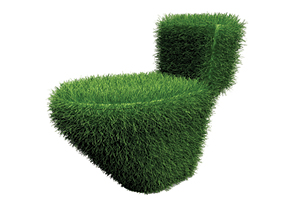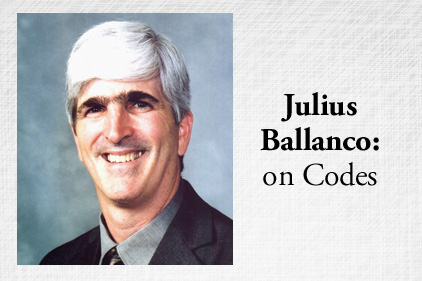
|
| Photo credit: ©istockphoto.com/JohnDoo |
The green codes are all undergoing updating, including the IAPMO Green Plumbing and Mechanical Green Code Supplement, the ICC International Green Construction Code, ASHRAE 189.1 and, of course, LEED version 4.
The common thread with all these documents is they don’t define “green.” They also don’t define “sustainable.” Both are nebulous terms used to set regulations. That is the problem everyone has in trying to decide what constitutes green.
This subject seemed to be skirted at the recent ASPE Technical Symposium. All four groups made presentations during the green code panel discussion. They were all excellent presentations, each providing a bit of a commercial for their particular document, which wasn’t a problem.
When the plumbing or mechanical codes are developed, they specify that the requirements are to protect public health, safety and welfare. Those are easy goals to try and achieve. However, these are not similar goals for green and sustainable.
Making matters more difficult is the approach taken by the U.S. Green Building Council with its LEED program. At the ASPE Technical Symposium, it readily admitted buildings obtaining Platinum status under its older requirements will just make it to Silver under the soon-to-be published new requirements. The USGBC further stated its objective is to continually raise the bar.
Looking at the other three documents, the question becomes, “How much green is green and where do we go from here?” A few other questions were raised as to what is sustainable and why plumbing products are not viewed for their sustainability?
Green mountain goats
I immediately thought about my backpacking trip this past summer to Olympic National Park in Washington state. It is a beautiful park for hiking, but of course there are no flush fixtures out in the wild. The outhouses were somewhat unique with boxes that pulled out of the rear and were flown away by helicopter to be treated. The sign on the outhouse said, “Poop and paper only.” Underneath, it said pee on the trail. That was the green approach.
When we talked to one of the park rangers in camp, he said he now tells people to pee just off the trail. Apparently, the mountain goats like the salts in the urine from the pee on the trail. As a result, there are posted signs warning about aggressive mountain goats. We found that they were very aggressive — one of those unintended consequences.
Of course, all of this is very green. There is no water used for flushing, the ground treats the urine and you have this wonderful composted material. I guess the only non-green aspect is flying poop and paper out of the wilderness via helicopter.
So, the question becomes, are outhouses the ultimate goal for LEED? Are they the goal of IAPMO, ICC and ASHRAE?
One of the questioners during the panel discussion asked, “How low can we go with water use?” The pioneers used outhouses. They only bathed once a year. Hence, they were very green.
When sustainability of plumbing material was discussed, the cast-iron industry pointed out the pipe is made with 100% recycled material. Of course, the plastic pipe industry always has responded that its products are made with material from the Earth and use much less energy. Both have valid points. This is probably why sustainable material has not been addressed for plumbing.
Food is another issue that has been avoided. Many ask, “What has that got to do with plumbing and mechanical?” Well, the plumbing industry has a green and sustainable way to deal with food waste. It is called the food waste disposer. Some greenies want food waste composted. I am not a big fan of composting because it stinks.
I was surprised to learn in the United States a half-pound of food waste is generated per person per day. Most of this food waste ends up in landfills. That is an incredible amount of food waste. Just multiply it by the population.
The disposer industry has pointed out that food waste can be turned into energy. Enough energy can be generated to produce up to nine times the energy it takes to operate the waste-water treatment plant. Of course, the waste-water treatment plant needs to have the right equipment to turn food waste into energy and fertilizer.
So, is this green and sustainable? To date, it has not been considered green by any of the green codes or standards. At least they are talking about it.
I only mention these concepts because they are subjects the committees with these documents handle. Have they been doing a good job of defining green? That is up to you to decide. Should the bar keep being raised? Again, you can have input.
With green codes becoming the rage, it really is time for the engineering community to pay more attention to what is being developed. The ICC has a deadline of Jan. 6, 2014, for proposed changes to the International Green Construction Code. The document’s plumbing and mechanical sections need work on defining green. The committee and ICC membership have left many green concepts on the cutting room floor, so to speak. They have been declared green, but not fully green.
IAPMO has a continuous updating process to its Green Code Supplement, meaning it continually asks for proposed code changes. You can submit something at any time. IAPMO currently is trying to finalize its 2015 edition of the supplement.
ASHRAE also seeks input for its standards. You can submit changes to the Standards Committee at any time. Of course, some proposals are held over for the next cycle. ASHRAE also seeks comments on its proposed draft of the new plumbing water conservation requirements.
Now is your chance to help define green. Take a look at these documents and start submitting changes or comments. These are codes that we are going to have to live with whether you believe in green or not.
This is a growing trend. You need to be involved in defining this nebulous term.



